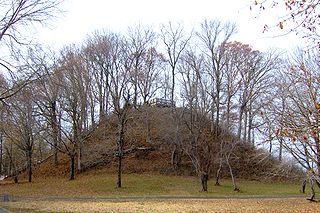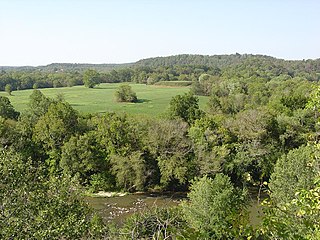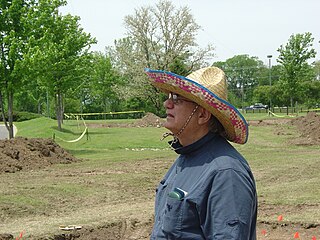The Tennessee Division of Archaeology (TDOA) is a division of the Tennessee Department of Environment and Conservation responsible for managing prehistoric archaeological sites on lands owned by the U.S. state of Tennessee, conducting archaeological excavations and research, informing the public about Tennessee’s prehistoric past, and coordinating with other state agencies regarding archaeological preservation issues.
The TDOA has two main divisions. The Technical Assistance Group is responsible for the protection of archaeological sites and artifacts on all lands owned or controlled by the state. This group also provides technical assistance for state agencies (including State Parks), law enforcement, municipalities, development communities, and the general public. Assistance is offered to public and private entities on legal and technical aspects of prehistoric Native American cemetery relocation and related concerns. This group also conducts research and publishes reports on archaeological subjects, some of which are available for free download via the Division of Archaeology website. The Site File and Review Group maintains accurate records on all known archaeological sites in the state, and coordinates with state agencies to assess impacts of proposed activities on known or suspected sites. This group also provides expertise to the State Historic Preservation Office by reviewing all federally funded projects within Tennessee to determine their impact on archaeological resources. The TDOA presently employs eight archaeologists, a site files coordinator, and an administrative secretary at the Nashville location. An auxiliary storage facility is located at Pinson Mounds State Park near Jackson, Tennessee.
Each January, the TDOA, in conjunction with the Middle Tennessee State University Department of Sociology and Anthropology, co-sponsors the Current Research in Tennessee Archaeology meeting. The meeting is open to the public and features presentations by both professional and avocational archaeologists.
History of the TDOA
Prior to the creation of the Tennessee Division of Archaeology (TDOA) in 1970, there had been State Archaeologists, but no state organization that was tasked with watching over Tennessee's archaeology sites. The first official State Archaeologist was Parmenio E. Cox , who was appointed to the role by Governor Austin Peay in 1924 after the death of William Edward Myer, who had served as the unofficial state archaeologist. Cox held the role until he died in 1932.
The TDOA was established in 1970 under the Department of Conservation through the "Tennessee Antiquities Act" (TCA 11-6-101-121), and the first staff members were hired in 1972, with Mack S. Prichard being appointed to the role of State Archaeologist in 1971. The TDOA had a very small budget when it was first created, which only allowed for the hiring of an assistant, which was Patti Coats. Prichard was able to secure additional funds and then hired three regional archaeologists and a Historical Archaeologist in 1972. These included Brian Butler (who oversaw the eastern part of the state,) John Broster (who oversaw the west), Carl Kuttruff (who oversaw Middle Tennessee), and Joe Benthall (who served as the first Historical Archaeologist).
Benthall became the state archaeologist after Mack Prichard retired in 1973 and Sam Smith was then hired to take over as the Historical Archaeologist. Patti Coats was also moved into the new position of Site Files Curator during this time. The Division experienced some structural changes during the late 1970s, which merged them with the TN State Parks Department. The position of State Archaeologist was eliminated at this time and Joseph Benthall was moved to a regional archaeologist position. Historical Archaeologist Sam Smith served as the acting State Archaeologist during this period. This merger was short-lived, however, with the TDOA again becoming its own Division in 1983 with the appointment of a new State Archaeologist, Nick Fielder, by Commissioner Charles A. Howell. Fielder had been serving as the first State Historic Preservation Office Archaeologist since 1976. He served as State Archaeologist until 2007, when he retired. Mike Moore then became the State Archaeologist in 2007 and still holds the position today. In 1991, the Department of Conservation merged with the Environment side of the former Department of Health and Environment to become the Department of Environment and Conservation (TDEC). The TDOA is still a Division of TDEC.
State-wide field projects have comprised an important Division mandate since the beginning. Significant investigations on state-owned properties include Mound Bottom, Sellars Farm, Pinson Mounds, Fort Loudoun, Ft. Pillow, Riverbend Prison, SR-42 (Algood), Hiwassee Old Town, Sandbar Village, Carter House (Williamson County), Spencer Youth Center, Special Needs Prison, Middle TN Veterans Cemetery, Bicentennial Mall, and Ropers Knob. Select site investigations on non-state lands include Brick Church Pike Mound, Fort Southwest Point, First Hermitage, Yearwood, Penitentiary Branch, Fort Blount, Brandywine Pointe, Coats-Hines Mastodon, Johnson, Old Town, Gordontown, Austin Cave, Carson-Conn-Short, Rutherford-Kizer, Brentwood Library, Moss-Wright and collaborative investigations along the Cumberland River near Nashville following the 2010 floods. Thematic historic site surveys (such as potteries, gunmaking, Highland Rim iron industry, Civil War, World War II, Rosenwald Schools, and Trail of Tears) have also been an important component of TDOA research. Reconnaissance surveys for prehistoric sites have been conducted within the Obion, Duck, Cumberland, Harpeth, Caney Fork, Collins, Calfkiller, and Hiwassee/Ocoee River watersheds.
The Division’s ability to perform larger-scale site excavations has significantly diminished over the years due to the same position reductions experienced by other state agencies. Division positions have been cut roughly 70% over the past 25 years, from about 35 positions during the mid-1980s to the current 10 positions. Most of the eliminated positions were part-time/seasonal posts used to employ project field crews. As a result, the TDOA now focuses on smaller-scale survey and site investigations, and also responds to emergency situations as possible.

The Pinson Mounds comprise a prehistoric Native American complex located in Madison County, Tennessee, in the region that is known as the Eastern Woodlands. The complex, which includes 17 mounds, an earthen geometric enclosure, and numerous habitation areas, was most likely built during the Middle Woodland period. The complex is the largest group of Middle Woodland mounds in the United States. Sauls' Mound, at 72 feet (22 m), is the second-highest surviving mound in the United States.
The Tennessee Department of Environment and Conservation (TDEC) is a Cabinet-level agency first created in 1937 within the government of the U.S. state of Tennessee, headed by the Tennessee Commissioner of Environment and Conservation.

Pinson is an unincorporated community in Madison County, Tennessee. It lies along U.S. Route 45 between Jackson and Henderson, just north of the Chester County line, and State Route 197 also passes through the community. It is included in the Jackson, Tennessee Metropolitan Statistical Area.

The Old Stone Fort is a prehistoric Native American structure located in Coffee County, Tennessee, in the Southeastern United States. The structure was most likely built between 80 and 550 AD during the Middle Woodland period. It is the most complex hilltop enclosure found in the South and was likely used for ceremonial purposes rather than defense.

Mound Bottom is a prehistoric Native American complex in Cheatham County, Tennessee, located in the Southeastern United States. The complex, which consists of earthen platform and burial mounds, a 7-acre central plaza, and habitation areas, was occupied between approximately 1000 and 1300 AD, during the Mississippian period.
David G. Anderson is an archaeologist in the department of anthropology at the University of Tennessee, Knoxville, who specializes in Southeastern archaeology. His professional interests include climate change and human response, exploring the development of cultural complexity in Eastern North America, maintaining and improving the nation's Cultural Resource management (CRM) program, teaching and writing about archaeology, and developing technical and popular syntheses of archaeological research. He is the project director of the on-line Paleoindian Database of the Americas (PIDBA). and a co-director, with Joshua J. Wells, Eric C, Kansa, and Sarah Whitcher Kansa, of the Digital Index of North American Archaeology (DINAA)
Dan Franklin Morse is an archaeologist specializing in the prehistory of the midwestern United States and the central Mississippi Valley, research summarized in a number of books, monographs, and technical articles. He is best known for his 1983 synthesis of the "Archaeology of the Central Mississippi Valley" with Phyllis A. Morse, and for his 1997 volume issued by the Smithsonian Institution Press on "Sloan: A Paleoindian Dalton Cemetery in Arkansas." The Sloan site is the location of the oldest marked cemetery found to date in the Americas. He conducted excavations on a great many other significant archaeological sites during his career, including at Brand, Cahokia, Nodena, Parkin, and Zebree. Morse retired from his posts as Survey Archeologist for the Arkansas Archaeological Survey and as Professor of Anthropology at the University of Arkansas in 1997, after 30 years of service, but continues to work on publications and interact with students and colleagues on sites.
Gerald F. Schroedl is a professor of anthropology at the University of Tennessee. He specializes in Southeastern United States and Caribbean prehistoric and historic archaeological sites. He is an authority on Cherokee prehistory and the archaeology of eastern Tennessee and western North Carolina.
The Coats–Hines–Litchy site is a paleontological site located in Williamson County, Tennessee, in the Southeastern United States. The site was formerly believed to be archaeological, and identified as one of only a very few locations in Eastern North America containing evidence of Paleoindian hunting of late Pleistocene proboscideans. Excavations at the site have yielded portions of four mastodon skeletons, including portions of one previously described as being in direct association with Paleoindian stone tools. The results of excavations have been published in Tennessee Conservationist, and the scholarly journals Current Research in the Pleistocene, Tennessee Archaeology, and Quaternary Science Reviews. The site was listed on the National Register of Historic Places on July 12, 2011.
The Dallas phase is an archaeological phase, within the Mississippian III period, in the South Appalachian Geologic province in North America.
Stone box graves were a method of burial used by Native Americans of the Mississippian culture in the Midwestern United States and the Southeastern United States. Their construction was especially common in the Cumberland River Basin, in settlements found around present-day Nashville, Tennessee.

Fewkes Group Archaeological Site, also known as the Boiling Springs Site, is a pre American history Native American archaeological site located in the city of Brentwood, in Williamson County, Tennessee. It is in Primm Historic Park on the grounds of Boiling Spring Academy, a historic schoolhouse established in 1830. The 15-acre site consists of the remains of a late Mississippian culture mound complex and village roughly dating to 1050-1475 AD. The site, which sits on the western bank of the Little Harpeth River, has five mounds, some used for burial and others, including the largest, were ceremonial platform mounds. The village was abandoned for unknown reasons around 1450. The site is named in honor of Dr. J. Walter Fewkes, the Chief of the Bureau of American Ethnology in 1920, who had visited the site and recognized its potential. While it was partially excavated by the landowner in 1895, archaeologist William E. Myer directed a second, more thorough excavation in October 1920. The report of his findings was published in the Bureau of American Ethnology's Forty-First Annual Report. Many of the artifacts recovered from the site are now housed at the Smithsonian Institution. It was added to the National Register of Historic Places on April 21, 1980, as NRIS number 80003880.
Lynne Sullivan is an American archaeologist and former Curator of Archaeology for the Frank H. McClung Museum located on the University of Tennessee campus in Knoxville, Tennessee. A graduate of the University of Tennessee (undergraduate) and the University of Wisconsin–Milwaukee, Sullivan is renowned for her research and publications on subjects such as Southeastern United States prehistory, Mississippian chiefdoms, mortuary analysis, and archaeological curation. She has been a major contributor to the feminist/gender archaeology movement through her studies in social inequality, gender roles, and the historic significance of women in the development of modern archaeology.
Charles Harrison McNutt III was an American archaeologist and a scholar of the prehistoric Southeastern United States. He conducted fieldwork and published works on the archaeology of the American Southwest and the Great Plains in South Dakota. His work emphasized on a strong understanding of cultural history and statistical analysis.
Madeline Kneberg Lewis (1903–1996) was an American archaeologist and professor of anthropology at the University of Tennessee. She is most famous for her work on excavations in the Tennessee Valley, beginning in the 1930s. She was instrumental in establishing the anthropology department at the University of Tennessee as well as the Frank H. McClung Museum. She was the first female full professor at Tennessee outside of home economics and among the first prominent female archaeologists in the United States.
Jefferson Chapman is an archaeologist who conducted extensive excavations at sites in eastern Tennessee, recovering evidence that provided the first secure radiocarbon chronology for Early and Middle Archaic period assemblages in Eastern North America. He also is a research professor in anthropology and the Director of the Frank H. McClung Museum at the University of Tennessee, Knoxville. Chapman’s professional interests include Southeastern archaeology, paleoethnobotany, museology and public archaeology.

John Bertram Broster is an American archaeologist formerly serving as the Prehistoric Archeological Supervisor at the Tennessee Division of Archaeology, Department of Environment and Conservation. He is best known for his work on the Paleoindian period of the American Southwest and Southeast, and has published some 38 book chapters and journal articles on the subject.

Too-Cowee, was an important historic Cherokee town located near the Little Tennessee River north of present-day Franklin, North Carolina. It also had a prehistoric platform mound and earlier village built by ancestral peoples. As their expression of public architecture, the Cherokee built a townhouse on top of the mound. It was the place for their community gatherings in their highly decentralized society. The name translates to "pig fat" in English. British traders and colonists referred to Cowee as one of the Cherokee Middle Towns along this river; they defined geographic groupings based in relation to their coastal settlements, such as Charlestown, South Carolina.
Hiwassee Island, also known as Jollys Island and Benham Island, is located in Meigs County, Tennessee, at the confluence of the Tennessee and Hiwassee Rivers. It is about 35 mi (56 km) northeast of Chattanooga. The island was the second largest land mass on the Tennessee River at 781 acres before the Tennessee Valley Authority created the Chickamauga Lake as a part of the dam system on the Tennessee River in 1940. Much of the island is now submerged, leaving 400 acres above the waterline.
Bennie Carlton Keel is an American archaeologist who has made contributions to the foundational understanding of Cherokee archaeology and culture, North Carolina archaeology, and to the development of Americanist cultural resource management (CRM).







